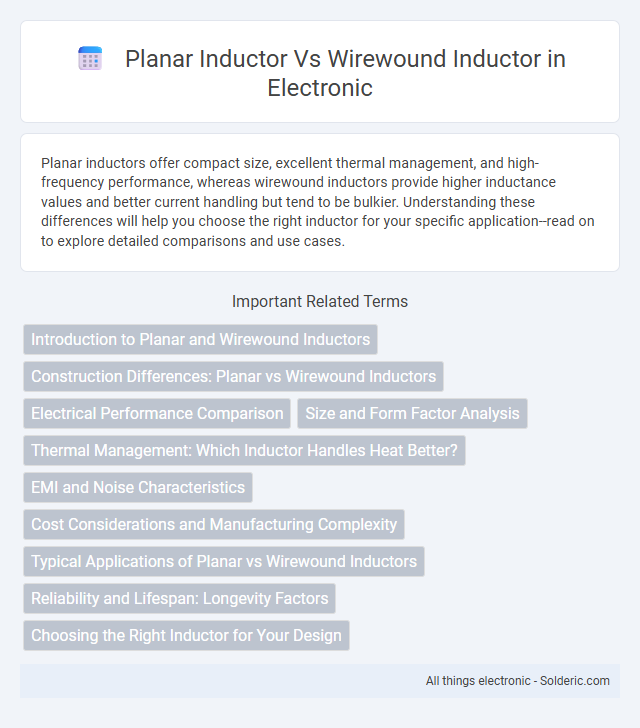Planar inductors offer compact size, excellent thermal management, and high-frequency performance, whereas wirewound inductors provide higher inductance values and better current handling but tend to be bulkier. Understanding these differences will help you choose the right inductor for your specific application--read on to explore detailed comparisons and use cases.
Comparison Table
| Feature | Planar Inductor | Wirewound Inductor |
|---|---|---|
| Construction | Flat spiral coils on PCB or ceramic substrate | Copper wire wound around a magnetic or air core |
| Size | Compact, low-profile | Bulkier, larger footprint |
| Frequency Range | High-frequency applications (MHz range) | Low to medium frequencies (kHz to low MHz) |
| Inductance Range | Low to moderate inductance (nH to mH) | Wide range, from nH to several mH |
| Quality Factor (Q) | Moderate Q, sensitive to substrate losses | High Q, efficient energy storage |
| Thermal Performance | Good heat dissipation due to planar structure | Depends on coil design, possible hot spots |
| Manufacturing | Batch fabrication, consistent, automated | Manual or semi-automated winding, less consistent |
| Cost | Cost-effective at high volumes | Lower cost at low volumes, higher labor cost |
| Applications | RF circuits, filters, power supplies | Power inductors, transformers, audio equipment |
Introduction to Planar and Wirewound Inductors
Planar inductors utilize flat, printed circuit board (PCB) traces to create magnetic fields, offering compact size and high frequency performance ideal for modern electronic devices. Wirewound inductors consist of copper wire coils wound around a magnetic core, providing higher inductance values and superior current handling suitable for power applications. Your choice between planar and wirewound inductors depends on factors like space constraints, frequency requirements, and power levels to achieve optimal circuit performance.
Construction Differences: Planar vs Wirewound Inductors
Planar inductors feature a flat, spiral winding etched onto a printed circuit board, offering low profile and efficient heat dissipation, while wirewound inductors consist of copper wire tightly wound around a magnetic core, providing higher inductance and current handling. The planar design enables precise inductance values and better high-frequency performance due to reduced parasitic effects, whereas wirewound inductors excel in applications requiring robust energy storage and minimal core losses. Your choice between these two depends on space constraints, frequency requirements, and current capacity needed for optimal circuit performance.
Electrical Performance Comparison
Planar inductors offer lower parasitic capacitance and higher self-resonant frequencies compared to wirewound inductors, making them ideal for high-frequency applications. Wirewound inductors typically provide higher inductance values and superior current handling due to their robust coil structure. Your choice depends on the required frequency range and current capacity, with planar inductors excelling in compact, high-frequency circuits while wirewound inductors are preferred for power and low-frequency uses.
Size and Form Factor Analysis
Planar inductors offer a compact size and low profile due to their flat, layered construction, making them ideal for high-frequency applications with space constraints. Wirewound inductors typically have a bulkier, cylindrical form factor caused by the coil winding on a core, resulting in larger footprints and height. Your choice between planar and wirewound inductors should consider the available space on the PCB and the required inductance performance within the given form factor.
Thermal Management: Which Inductor Handles Heat Better?
Planar inductors excel in thermal management due to their flat, spread-out structure, which increases surface area and enhances heat dissipation compared to wirewound inductors. Wirewound inductors, with their tightly coiled wire, can trap heat within the windings, making them less efficient in preventing thermal buildup. When your application demands high power and effective heat handling, planar inductors typically offer superior performance and reliability under thermal stress.
EMI and Noise Characteristics
Planar inductors exhibit lower electromagnetic interference (EMI) and reduced noise levels compared to wirewound inductors due to their flat, multilayer construction that minimizes parasitic capacitance and coupling. Wirewound inductors typically generate higher EMI as their coil structure creates stronger magnetic fields and increased flux leakage, which can induce noise in nearby circuits. Optimal EMI suppression in planar inductors makes them preferable for high-frequency applications requiring stringent noise control.
Cost Considerations and Manufacturing Complexity
Planar inductors generally offer lower manufacturing complexity due to automated PCB-based fabrication processes, reducing labor costs compared to wirewound inductors, which require precise manual or semi-automated winding. Wirewound inductors often incur higher material costs because of expensive magnetic cores and copper wire, whereas planar inductors use less copper and no bulky cores, lowering overall expense for high-volume production. Cost considerations favor planar inductors for compact, mass-produced electronics, while wirewound designs remain competitive in low-volume or high-performance applications requiring higher inductance values.
Typical Applications of Planar vs Wirewound Inductors
Planar inductors excel in high-frequency applications such as RF circuits, power supplies for compact devices, and surface-mount technology where low profile and thermal management are critical. Wirewound inductors are preferred in power electronics, audio equipment, and filtering applications requiring higher inductance values and current handling capabilities. Your choice depends on the specific frequency, size constraints, and current requirements of the application.
Reliability and Lifespan: Longevity Factors
Planar inductors offer superior reliability and longer lifespan due to their low-profile design and enhanced thermal management, reducing stress and wear on the component. Wirewound inductors, while robust, are more prone to mechanical fatigue and thermal cycling effects, potentially shortening their operational life. Choosing a planar inductor for your application can improve durability by minimizing failure modes related to winding deformation and insulation breakdown.
Choosing the Right Inductor for Your Design
Planar inductors offer low profile, high-frequency performance, and excellent thermal management, making them ideal for compact, high-speed applications such as RF circuits and power supplies in modern electronics. Wirewound inductors provide higher current ratings and better saturation characteristics, suitable for power conversion and filtering in automotive or industrial systems requiring robust magnetic properties. Selecting the right inductor depends on balancing factors like frequency response, size constraints, current capacity, and thermal performance to match the specific requirements of your electronic design.
Planar inductor vs wirewound inductor Infographic

 solderic.com
solderic.com